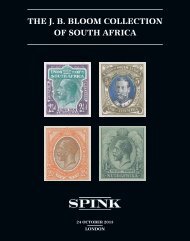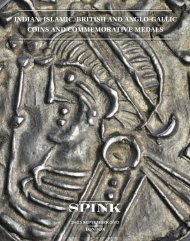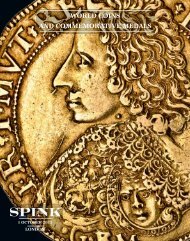bentley priory - Spink
bentley priory - Spink
bentley priory - Spink
You also want an ePaper? Increase the reach of your titles
YUMPU automatically turns print PDFs into web optimized ePapers that Google loves.
THE BENTLEY PRIORY BATTLE OF BRITAIN TRUST APPEAL CHARITY AUCTION<br />
A Brief Interlude With de Havilland And The Mosquito<br />
Prototype<br />
Shortly after his first ‘Victory’ Cunningham was asked to see<br />
Sir Charles Portal, Chief of the Air Staff, at the Air Ministry;<br />
having no idea what the meeting was about, ‘he was ushered<br />
in and was very relieved to learn that his former boss, Captain<br />
de Havilland, had asked Portal if he could have John’s<br />
services for a day to fly his new machine - the D.H. 98<br />
Mosquito - and make a judgement as to its suitability as a<br />
night fighter.’ (ibid)<br />
On the 2nd of February 1941 Cunningham flew to his old<br />
stomping ground at Hatfield, ‘shortly afterwards he got his<br />
first glimpse of the Mosquito. ‘I was overjoyed’, he said. ‘It<br />
had a marvellous shape and was a typically elegant looking<br />
D.H. aeroplane following the lines of the D.H. Albatross... It<br />
was light on the controls, and lovely in the air’, he said. ‘Its<br />
performance matched its elegance, and I was convinced that<br />
it had great night fighter potential.’<br />
Cunningham was the first Service pilot to fly the Mosquito,<br />
and the aircraft was subsequently taken to the Boscombe<br />
Down testing airfield for Service trials.<br />
‘Cat’s Eyes’ - The Start Of A Legend<br />
604 Squadron now altered their tactics and from December<br />
onwards tried to make contact with the German bombers<br />
whilst they were still out at sea; on the 23rd December<br />
Cunningham took off with Phillipson on one of these patrols,<br />
‘at five o’clock, when it was already getting dark on the<br />
ground, they spotted a Heinkel 111 coming in about fifty<br />
miles out at sea. At 15,000 feet, however, it was still daylight.<br />
John calmly bided his time stalking the pathfinder, and then,<br />
firing his cannons, hit him squarely in the bombload. The<br />
Heinkel blew up like a gigantic firework display, with<br />
coloured flares and burning incendiaries showering out as the<br />
machine plummeted down in a near-vertical dive. Finally it<br />
disappeared through cloud with three parachute flares, which<br />
had fallen out, dramatically lighting the scene.<br />
John’s first kill, the Ju 88 on 20 November, had generated<br />
confidence amongst all those engaged in the night fighting<br />
business. The long suffering public, who were enduring<br />
constant bombing raids, needed some encouragement, and<br />
the fact that our night fighter force was at last achieving<br />
results was to become the subject of satisfying Press<br />
comment, to lift morale. However, neither the public nor<br />
even most of those in the Services knew anything about the<br />
‘magic box’. It had to be kept secret. So a legend was created<br />
which boosted the public image of the night fighter, and<br />
effectively cloaked the secret.<br />
The Press were allowed to publish pictures of John<br />
Cunningham - the first night ace - whose night vision was<br />
said to be so miraculous that it enabled him to see in the dark,<br />
as with the eyes of a cat. Inevitably, from then on he was<br />
known throughout the country as ‘Cat’s Eyes’ Cunningham’.<br />
It was also said that he ate lots of carrots, whose Vitamin A<br />
content helped to maintain his supposed extraordinary night<br />
vision.’ (ibid)<br />
Despite being unpopular with the man himself, who was<br />
uncomfortable with being singled out from other pilot’s<br />
achievements, ‘the branding of John as ‘Cat’s Eyes’<br />
Cunningham, the ace night fighter, achieved its object in<br />
making people aware that Great Britain actually did have a<br />
night fighter force, which was rapidly becoming an increasing<br />
deterrent to German night bombers. The public at that time<br />
were under severe strain and ready to accept any news which<br />
gave them a lift, such as the Cats Eyes and carrots<br />
explanation! The Germans must have known from their<br />
casualty figures - 604 Squadron destroyed thirty bombers in<br />
one two-month period - that the RAF was either improving<br />
its techniques or had something special. However it appeared<br />
that the Cunningham press comment had effectively cloaked<br />
the secret of the ‘magic box’.<br />
The introduction on the South Coast of the local GCI<br />
stations was also an important factor in starting to turn the<br />
tide, ‘these enabled every night fighter to be vectored by a<br />
Controller, who could follow the entire course of an<br />
interception on a large cathode-ray tube, and who could<br />
direct the fighter until he had brought it within a mile or so<br />
behind the bomber’. (ibid)<br />
Cunningham And Rawnsley - A Permanent Partnership<br />
Up to this point in the War Cunningham had flown the<br />
majority of his successful operations with Sergeant Phillipson,<br />
and on 2.1.1941 they got another Probable, ‘Fighter Patrol<br />
- Dusk Patrol - intercepted He 111 in Lyme Bay - Probable’<br />
(Log Book refers); this was to be their last success together as<br />
during the second week of January Rawnsley regained his<br />
partnership with Cunningham as his radar operator, ‘his long<br />
experience of flying with John from the Hawker Demon had<br />
enabled him to understand John’s manner and style in the air.<br />
John’s voice was even more brisk and economical while<br />
flying, and there was never any casual conversation. John’s<br />
patience and Jimmy’s honesty were essential ingredients in<br />
establishing a natural co-ordination between them. Jimmy<br />
always admitted liability for his mistakes, and did his best to<br />
eradicate them, while some of the other operators covered up<br />
by giving pseudo-technical reasons.’ (ibid)<br />
It did not take long for the pair to find their feet, scoring a<br />
He 111 damaged, 12.1.1941, before achieving their first<br />
victory together over Poole Harbour, 15.2.1941, ‘they<br />
reached their patrol point at 15,000 feet, some forty miles<br />
south of Lulworth, and began going up and down the line.<br />
Jimmy had his AI warmed up and tuned in, ready for a radar<br />
search.... he looked intently towards the south-west, from<br />
where the Heinkels would come.<br />
Minutes later the Controller told them that the first bandit<br />
was on its way flying at 12,000 feet, and right on his track.<br />
Then began the cat and mouse came in which John excelled.<br />
He dropped down to 11,500 feet into the misty obscurity<br />
that lay shorewards, leaving the enemy silhouetted against the<br />
luminous background. John made no move and continued<br />
on his beat as the minutes ticked by... Then Jimmy suddenly<br />
spotted the German visually high on the port quarter, a tiny<br />
black speck still miles away but easily picked out against the<br />
light sky.<br />
When he reported the bandits position, John turned the Beau<br />
smartly around on its wingtip.<br />
The Heinkel was coming fast, and was soon high overhead,<br />
and John kept vertically beneath it. He managed to stay in<br />
position by keeping watch through the roof panel as the<br />
bandit flew serenely on, blissfully unaware of what was<br />
lurking below. For ten minutes or more the two aircraft<br />
continued in company, while all the time night time was<br />
approaching.<br />
When the Dorset coast became visible the Heinkel started to<br />
circle and John followed him, glancing up to the bomber and<br />
down to his instruments. The German was biding his time,<br />
waiting for the cloak of darkness before he crossed into<br />
hostile territory. Round they went, with John maintaining<br />
station until the curve of Lyme Bay was close ahead... The<br />
night was descending fast when John pounced.<br />
He increased power, and the Beaufighter rose towards its<br />
quarry, so that the Heinkel grew ever larger above their<br />
heads. Jimmy was filled with a ridiculous sense of the need to<br />
go on tiptoe, as if he were stalking the enemy. He checked<br />
the AI, the safety catches on the Hispano cannon, and the air<br />
pressure in the firing circuit, and then he checked the sky<br />
behind and below. He told John that he was ready, and there<br />
was nothing behind.<br />
‘Good’, John replied, ‘Here goes’. The Heinkel slowly sank<br />
into the line of fire as Jimmy anxiously waited, expecting a<br />
stream of tracer from a German gunner. Then John pressed<br />
the gun button and released an avalanche of 20mm shells...<br />
Then, just beyond the line of flame, there was an angry red<br />
explosion and they knew that the Heinkel had gone in’. (ibid)<br />
Cunningham piloted his Beaufighter like a predatory cat<br />
stalking his prey - as a consequence it would appear that his<br />
WWW.SPINK.COM

















